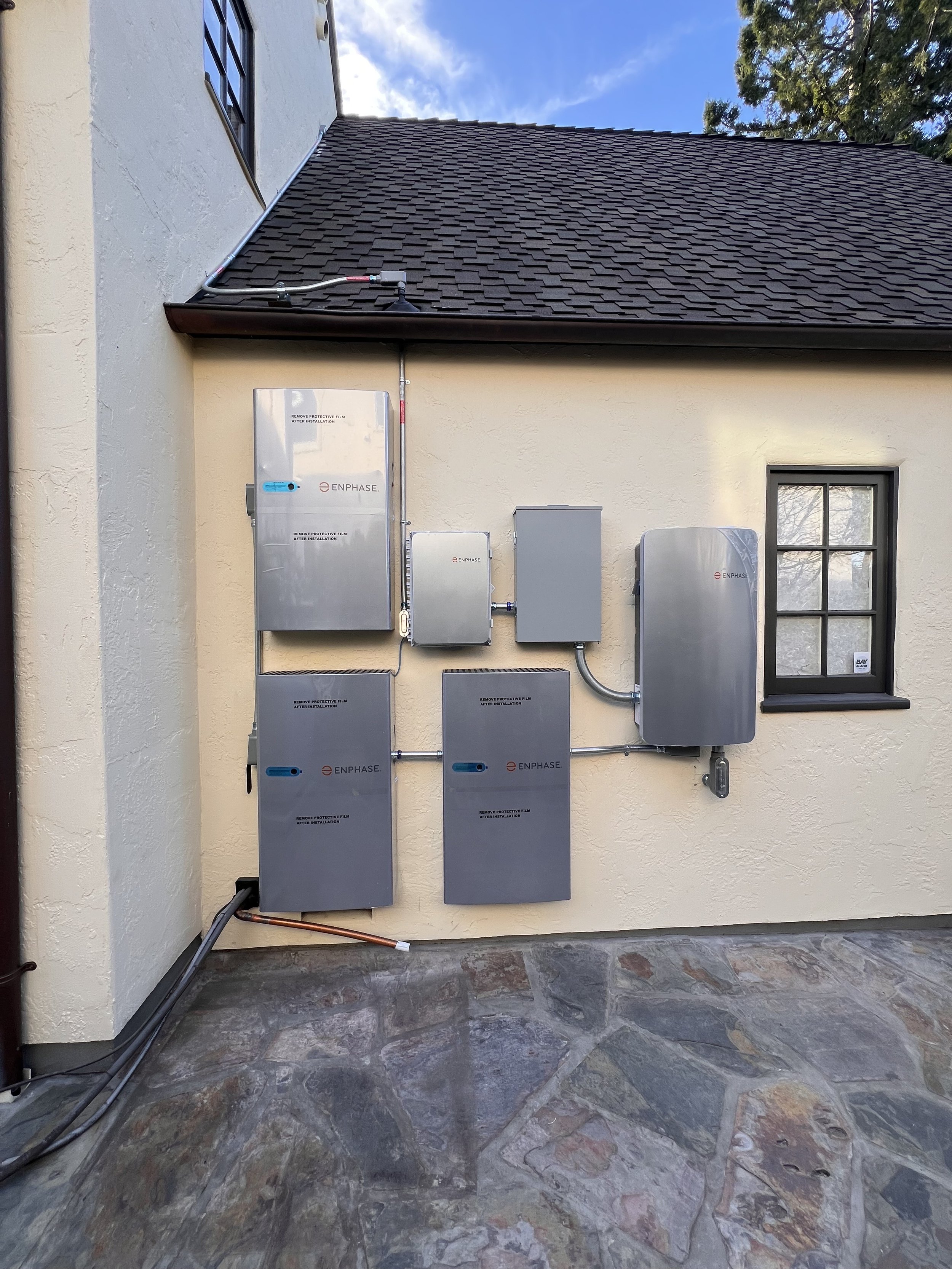The Importance of a Sound Roof Before Installing Solar Panels in the Bay Area
When it comes to installing solar panels in the Bay Area—specifically in cities like Berkeley, Oakland, Richmond, El Cerrito, and Piedmont—the condition of your roof is just as important as the solar system itself. Before you make the leap to clean, renewable energy, it’s crucial to ensure your roof is in excellent condition. A solid, well-maintained roof will help ensure the longevity and efficiency of your solar installation, allowing you to get the most out of your investment.
Why Roof Condition Matters for Solar Panel Installations
Roof Stability and Structural Integrity Solar panels require a secure mounting system to stay in place for decades. If your roof is weakened or damaged, it may not be able to support the weight of the solar panels, which could lead to potential damage to both your roof and your solar system. In the Bay Area, where weather conditions can vary, a structurally sound roof is essential for long-term solar energy performance.
Roof Age and Lifespan Roofs, like solar panels, have lifespans. Most roofs last between 20-30 years, and solar panels typically last 25-30 years. If your roof is approaching the end of its useful life, installing solar panels could create complications down the road. You don’t want to install panels on a roof that might need to be replaced in just a few years. Replacing your roof before installation will save you the cost and hassle of removing and reinstalling solar panels in the future.
Energy Efficiency and Protection A well-maintained roof helps regulate your home’s energy efficiency. If your roof is old or has damage, it can lead to air leaks, which makes your home less energy-efficient. A new or well-maintained roof, paired with a high-performance solar energy system, will maximize your home’s energy efficiency and help keep heating and cooling costs low.
What to Do Before Installing Solar Panels in the Bay Area
Before moving forward with a solar installation in cities like Berkeley, Oakland, Richmond, El Cerrito, and Piedmont, it’s important to have your roof inspected by a professional. A roofing expert will assess the overall condition of your roof, check for damage or wear, and ensure there are no issues that could affect your solar system’s performance.
Partnering with a Trusted Roofing Company in the Bay Area
If you're unsure about the condition of your roof, we recommend working with a trusted local roofing partner, like Collins Roofing Company. Specializing in roofing services across the Bay Area, their team can inspect, repair, or replace your roof to ensure it’s in top condition for solar panel installation. They are experts in ensuring that your roof is stable and ready for a seamless solar installation.
Protect Your Home and Investment with a Solid Roof
In the Bay Area, having a sound roof is key to ensuring your solar panel system operates efficiently for years. Before moving forward with solar installation, make sure your roof is up to the task. Whether you're in Berkeley, Oakland, Richmond, El Cerrito, or Piedmont, working with a professional roofing company like COLLINS ROOFING, one of the oldest Roofing Company in Oakland ensures your roof is prepared to support your new solar system and protect your investment.
Reach out today for a roof inspection, and take the first step towards a cleaner, more energy-efficient future.
Collins Roofing
3756 Grand Avenue Suite 304
Oakland, CA 94610
(510) 444-2220
email: office.collinsroofing@gmail.com
Permanent Battery Storage Rebate Find out if you qualify for a $7,500 rebate on a permanent battery storage system
Power outages are a common occurrence in California, especially during extreme weather events. Whether due to wildfires, storms, or public safety power shutoffs, it’s essential for homeowners to have reliable backup power to ensure that critical appliances, equipment, and electronics keep running. To help homeowners safeguard their homes, PG&E is offering a $7,500 rebate on the purchase and installation of permanent battery storage systems.
What is the Permanent Battery Storage Rebate?
The Permanent Battery Storage Rebate from PG&E is designed to encourage homeowners to install a backup battery system for emergency situations. The rebate is available to first-time PG&E battery storage customers who meet the eligibility requirements and agree to install a permanent battery storage system that provides backup power during an outage.
This rebate offers up to $7,500 toward the cost of purchasing and installing a qualified permanent battery storage system. It is available on a first-come, first-served basis, while funding lasts. However, currently, 190,000 PG&E customers are eligible for this program, but only 600 customers will receive funding.
Benefits of Backup Power
By installing a battery storage system, homeowners can ensure their homes are prepared for power outages. Backup power systems provide several critical benefits:
Keep the lights on: Power your home during an outage, avoiding disruptions in daily life.
Help appliances stay running: Ensure essential appliances such as refrigerators and freezers continue operating.
Save perishable food: Keep food safe and fresh by maintaining refrigeration.
Power essential equipment: Keep important electronics and medical devices powered during an outage.
Eligibility Requirements
To qualify for the Permanent Battery Storage Rebate, applicants must meet the following criteria:
PG&E Residential Customer: You must be a residential electric service customer of PG&E.
First-time Battery Storage Customer: This program is specifically for first-time battery storage customers with PG&E.
Outage History: You must have experienced five or more Enhanced Powerline Safety Settings outages since January 1, 2023.
Qualified Battery: Your battery system must be on PG&E’s Qualified Product List.
Permission to Operate: The permanent battery storage system must be installed and have received Permission to Operate from PG&E’s Electric Generation Interconnection (EGI) Department.
Time-of-Use Rate Plan: You must be enrolled in a PG&E Time-of-Use rate plan.
PG&E Demand Response: You must be enrolled in PG&E’s Demand Response Program or a similar equivalent program as determined by PG&E.
Solar Customers: If you have solar panels, you should check with your solar provider to ensure the battery is compatible with your system.
Important Details:
Standalone Battery: The battery can be a standalone backup system without requiring an existing solar setup. It’s not mandatory to have solar panels to qualify for the rebate, making this an accessible option for many homeowners who just need reliable backup power.
No Income Limit: There are no income restrictions for eligibility, so all PG&E customers who meet the other qualifications can apply for the rebate.
Backup Only: This battery storage system can also be used as backup power only. If you're only interested in using the system for backup purposes and don’t want it tied to your solar or grid usage, this option is available. Most likely, any eligibility will align with what SGIP allows—we will follow up with more specific details.
Separate Cost Breakdown: You do not need to include the full cost of the installation and materials in your original contract. You can place the material and labor costs on a separate sheet to be submitted for review.
How to Apply
The application process is straightforward, but there are important deadlines to keep in mind:
Eligibility Verification: First, check if you're eligible by entering your address in the Permanent Battery Storage Rebate Address Lookup Tool on PG&E’s website.
Address Lookup Tool
Submit Application: Applications must be submitted within 12 months from the purchase date or by December 31, 2025, whichever is sooner. Note that the application cannot be submitted until your battery system has been installed and received Permission to Operate from PG&E.
Rebate Limit: The rebate is one per household, regardless of the system size or quantity installed.
Allow Enough Time: Ensure that you have ample time to purchase, install, interconnect the system, and submit the application.
Dual Participation and Other Considerations
It’s important to note that PG&E’s new battery storage rebate can also be combined with other incentives, such as the Self-Generation Incentive Program (SGIP), although you should check the terms and conditions to ensure eligibility. However, there are some restrictions when combining incentives, so be sure to confirm whether the battery storage system you are purchasing is eligible for both programs.
What Does the Rebate Cover?
The $7,500 rebate is designed to offset the costs of purchasing and installing a permanent battery storage system, which can provide critical backup power during outages. However, it's important to remember that labor costs and other additional system components (like gateways or controllers) are not included in the rebate. Only the battery storage system itself is eligible for the rebate.
Conclusion
PG&E’s Permanent Battery Storage Rebate offers a fantastic opportunity for homeowners to invest in reliable backup power. Not only will this help ensure that your home is prepared for unexpected power outages, but it also provides a substantial rebate to reduce the financial burden of installing a battery storage system. If you meet the eligibility criteria, this program can help you protect your home and ensure peace of mind during outages.
To find out if you qualify, visit PG&E’s website and use the address lookup tool to check your eligibility:
Permanent Battery Storage Rebate Eligibility
Have questions or want to find out if you qualify? Feel free to give us a call! (510) 559-7700 or email us at nsaglam@allyelectricandsolar.com. We're here to help guide you through the application process and make sure you get the most out of your rebate. Don’t wait, as funding is limited and this is a first-come, first-served program.
How Cheap EV Charger Installations Could Affect Your Home Insurance
When it comes to installing an EV charger, opting for cheaper materials or substandard installation can have serious consequences—not only for your safety but also for your home insurance coverage. Here’s how insurance companies typically view cheap or improper installations:
1. Impact of Cheap Materials:
Aluminum Wiring: Some cheap installations use aluminum wire instead of copper, which is more prone to corrosion and expansion/contraction. This can lead to loose connections, overheating, and an increased risk of fire hazards. Home insurance companies are particularly cautious about aluminum wiring and may view it as a safety risk that could lead to denied claims if something goes wrong.
Substandard Equipment: Using cheaper, uncertified chargers or components without proper safety certifications can lead to malfunctions, fires, or damage. Insurers often require that all electrical installations meet safety standards, and using low-quality equipment might void your coverage.
2. Insurance Coverage and Risk:
Risk Assessment: Insurance providers assess the risk of electrical fires and property damage. An improperly installed EV charger using cheap materials increases this risk, which could result in higher premiums or a denied claim if something goes wrong.
Non-compliance with Codes: If the installation doesn’t meet local electrical codes or safety regulations, insurers may refuse to cover damages caused by faulty installations. They may also require that the installation be brought up to code before approving any future claims or renewing your policy.
3. Liability Concerns:
If an incident occurs due to poor installation, such as a fire caused by overheating or faulty wiring, your insurance company may shift liability onto you for not using a licensed professional or for using materials that don't meet safety standards.
4. How to Ensure Proper Coverage:
Hire a Licensed Electrician: Always use a licensed professional for installation to ensure safety and compliance with local codes.
Use Certified Equipment: Ensure that the charger and all materials are UL-listed or certified to meet national safety standards.
Document the Installation: Keep records of your installation, including invoices, permits, and inspection reports, to provide proof of proper installation in case of a claim.
Cheap or improper EV charger installations can increase your insurance risk and potentially void coverage. Insurers are particularly cautious about aluminum wiring and substandard equipment, and may deny claims or raise premiums if safety standards aren’t met. To protect your home and ensure reliable coverage, invest in quality materials and hire a licensed electrician for your EV charger installation.


